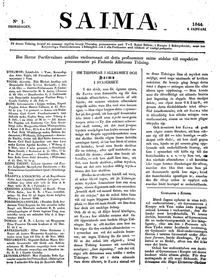Saima was a Swedish language weekly newspaper which was published in Kuopio, Finland.[1] It was one of the first Swedish language newspapers in Finland. The paper adopted the libertarian theory of the press[2] which would lead to its closure in 1846 soon after its start in 1844.
 First issue of Saima | |
| Type | Weekly newspaper |
|---|---|
| Founder(s) | Johan Vilhelm Snellman |
| Founded | 4 January 1844 |
| Language | Swedish |
| Ceased publication | 31 December 1846 |
| Headquarters | Kuopio |
| Country | Finland |
History and profile edit
Saima was founded by Johan Vilhelm Snellman, a Swedish-origin Finnish politician, in 1844.[1] Its first issue appeared on 4 January 1844.[3][4] Snellman was also the editor-in-chief of the paper which was one of the earliest examples of the active and critical publications.[5][6] The paper was headquartered in Kuopio[7][8] and came out weekly.[9] It addressed the Swedish-speaking upper and middle classes.[10] Soon after its start Saima became one of the leading publications in the country.[10]
Snellman published articles on nationality, language and literature in the paper.[11] He argued in an article in the second issue of Saima dated January 1844 that Finland did not have a national literature.[11] The paper ceased publication in 1846 when it was banned by the Russian Governor General Aleksandr Mensjikov due to its liberal political and cultural stance which were considered to be a threat to the rule of Grand Duke of Finland, Nicholas I.[6][8][10] The last issue of Saima appeared on 31 December 1846.[3]
References edit
- ^ a b Jani Marjanen; et al. (2019). "A National Public Sphere? Analyzing the Language, Location, and Form of Newspapers in Finland, 1771–1917". Journal of European Periodical Studies. 4 (1): 61. doi:10.21825/jeps.v4i1.10483. hdl:10138/309943. S2CID 203491119.
- ^ Jukka Kortti (2018). "Religion and the cultural public sphere: The case of the Finnish liberal intelligentsia during the turmoil of the early twentieth century". History of European Ideas. 44 (1): 101. doi:10.1080/01916599.2017.1402800. hdl:10138/230911. S2CID 149117943.
- ^ a b "Saima". Digital Collections. National Library of Finland. Retrieved 22 January 2024.
- ^ "Saima nro 1, 4.1.1844". Selected Works of J V. Snellman. Retrieved 22 January 2024.
- ^ Jyrki Loima (2014). "A Case Study of Education and Nationalism: The Multicultural Fight for "Souls and Minds" in Finland, 1891–1921". The Historian. 76 (4): 752. doi:10.1111/hisn.12052. S2CID 142537776.
- ^ a b Ilkka Mäkinen (Winter 2015). "From Literacy to Love of Reading: The Fennomanian Ideology of Reading in the 19th-century Finland". Journal of Social History. 49 (2): 294. doi:10.1093/jsh/shv039.
- ^ Torsten Steinby (May 1963). "The Swedish Language Press in Finland". Gazette. 9 (2): 151. doi:10.1177/001654926300900213. S2CID 144564245.
- ^ a b Kaarle Nordenstreng (2017). "Freedom of Speech in Finland 1766-2016: A Byproduct of Political Struggles" (Book chapter). trepo.tuni.fi. hdl:10024/101849. Retrieved 11 June 2023.
- ^ Kaarle Nordenstreng (2017). "Freedom of Speech in Finland 1766-2016. A Byproduct of Political Struggles". In Ulla Carlsson; David Goldberg (eds.). The Legacy of Peter Forsskål. 250 Years of Freedom of Expression. Nordicom. p. 78. ISBN 978-91-87957-63-5.
- ^ a b c John H. Wuorinen (1965). A History of Finland. Chichester, NY; West Sussex: Columbia University Press. p. 157. doi:10.7312/wuor91426. ISBN 9780231883689.
- ^ a b Ilkka Mäkinen (2016). "Found in Translations: J.V. Snellman's (1806–1881) Thoughts on Translations as a way to Strengthen the Finnish National Literature". Knygotyra. 66: 52. doi:10.15388/kn.v66i0.10017.